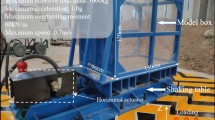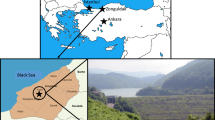Abstract
A probabilistic seismic loss assessment of RC high-rise (RCHR) buildings designed according to Eurocode 8 and located in the Southern Euro-Mediterranean zone is presented herein. The loss assessment methodology is based on a comprehensive simulation approach which takes into account ground motion (GM) uncertainty, and the random effects in seismic demand, as well as in predicting the damage states (DSs). The methodology is implemented on three RCHR buildings of 20-story, 30-story and 40-story with a core wall structural system. The loss functions described by a cumulative lognormal probability distribution are obtained for two intensity levels for a large set of simulations (NLTHAs) based on 60 GM records with a wide range of magnitude (M), distance to source (R) and different site soil conditions (SS). The losses expressed in percent of building replacement cost for RCHR buildings are obtained. In the estimation of losses, both structural (S) and nonstructural (NS) damage for four DSs are considered. The effect of different GM characteristics (M, R and SS) on the obtained losses are investigated. Finally, the estimated performance of the RCHR buildings are checked to ensure that they fulfill limit state requirements according to Eurocode 8.
Similar content being viewed by others
References
Ambraseys N, Smit P, Douglas J, Margaris B, Sigbjörnsson R, Ólafsson S, Suhadolc P and Costa G (2004), “Internet Site for European Strong-Motion Data,” Bollettino di Geofisica Teorica ed Applicata, 45(3): 113–129.
ATC-58 (2011), Guidelines for Seismic Performance Assessment of Buildings (75% Draft), Applied Technology Council, Redwood City, CA, USA.
Bachman RE (2004), “The ATC-58 Project Plan For Nonstructural Components, Performance-Based Seismic Design: Concepts and Implementation,” PEER Report 2004/05, Bled, Slovenia, pp. 125–136.
Bradley BA and Lee DS (2010), “Component Correlations in Structure-Specific Seismic Loss Estimation,” Earthquake Engineering Structural Dynamics, 39(3): 237–258.
Cardone D, Perrone G and Flora A (2020), “Displacement-Based Simplified Seismic Loss Assessment of Pre-70S RC Buildings,” Journal of Earthquake Engineering, 24(S1): 82–113.
Cornell CA and Krawinkler H (2000), “Progress and Challenges in Seismic Performance Assessment,” PEER Center News, 3: 1–3.
CSI (2006), PERFORM 3D Non-Linear Analysis and Performance Assessment for 3D Structures, Computers & Structures Inc, Berkeley, USA.
Deierlein GG (2004), “Overview of a Framework Methodology for Earthquake Performance Assessment, Performance-Based Seismic Design: Concepts and Implementation,” PEER Report 2004/05, Bled, Slovenia, pp. 15–26.
EN 1992-1-1 (2004), Eurocode 2: Design of Concrete Structures - Part 1-1: General Rules and Rules for Buildings, European Committee for Standardization, Brussels.
EN 1998-1 (2004), Eurocode 8: Design of Structures for Earthquake Resistance—Part 1: General Rules, Seismic Actions and Rules for Buildings, European Committee for Standardization, Brussels.
EN 1998-3 (2005), Eurocode 8: Design of Structures for Earthquake Resistance - Part 3: Assessment and Retrofitting of Buildings, European Committee for Standardization, Brussels.
Erberik M and Elnashai A (2004), “Fragility Analysis of Flat–slab Structures,” Engineering Structures, 26(7): 937–948.
ETABS (2013), Integrated Analysis, Design and Drafting of Buildings Systems, CSI Computers and Structures Inc.
Gentile R and Galasso C (2021), “Simplified Seismic Loss Assessment for Optimal Structural Retrofit of RC Buildings,” Earthquake Spectra, 37(1): 346–365.
Giardini D, Woessner J, Danciu L, Crowley H, Cotton F, Grünthal G, Pinho R, Valensise G and the SHARE Consortium (2013), SHARE European Seismic Hazard Map, European Commission, www.share-eu.org.
HAZUS (2003), HAZUS®MH–MR4 Technical Manual-Multi-Hazard Loss Estimation Methodology - Earthquake Model, Federal Emergency Management Agency, Washington, DC, USA.
Ji J, Elnashai AS and Kuchma DA (2007), “Seismic Fragility Assessment for Reinforced Concrete High-Rise Buildings,” Report 07-14, Mid-America Earthquake Center, University of Illinois at Urbana-Champaign, USA.
Kappos AJ and Panagopoulos G (2010), “Fragility Curves for Reinforced Concrete Buildings in Greece,” Structure and Infrastructure Engineering, 6(1–2): 39–53.
Koduru SD and Haukaas T (2010), “Probabilistic Seismic Loss Assessment of a Vancouver High-Rise Building,” ASCE Journal of Structural Engineering, 136(3): 235–245.
Matsumura K (1992), “On the Intensity Measure of String Motions Related to Structural Failures,” Proceedings 18 10WCEE, Vol.1, pp. 375–380.
Mehanny SS and Deierlein GG (2000), “Modeling of Assessment of Seismic Performance of Composite Frames with Reinforced Concrete Columns and Steel Beams,” Rep. No. 135, John A. Blume Earthquake Engineering Center, Dept. of Civil and Environmental Engineering, Stanford Univ., Stanford, Calif, USA.
Miranda E, Aslani H and Taghavi S (2004), “Assessment of Seismic Performance in Terms of Economic Losses,” Proceedings, International Workshop on Performance-Based Seismic Design: Concepts and Implementation, Bled, Slovenia, pp. 149–160.
Moehle J and Deierlein G (2004), “A Framework Methodology for Performance-Based Earthquake Engineering,” 13th World Conference on Earthquake Engineering, Vancouver, BC, Canada.
PEER GM (2010), “Technical Report for the PEER Ground Motion Database Web Application,” Pacific Earthquake Engineering Research Center, University of California, Berkeley, CA, USA.
PEER (2010), “Seismic Design Guidelines for Tall Buildings,” Report No. PEER-2010/05, PEER Pacific Earthquake Engineering Research Center, University of California, Berkeley, CA, USA.
PEER (2017), “Guidelines for Performance - Based Seismic Design of Tall Buildings,” Report No. 2017/06, PEER Pacific Earthquake Engineering Research Center, University of California, Berkeley, CA, USA.
PEER TBI (2017), “Tall Buildings Initiative,” Report, PEER Pacific Earthquake Engineering Research Center, University of California, Berkeley, CA, USA.
Pejovic J and Jankovic S (2015), “Dependence of RC High-Rise Buildings Response on the Earthquake Intensity,” Journal of the Croatian Association of Civil Engineers–Građevinar, 67(8): 749–759.
Pejovic J and Jankovic S (2016), “Seismic Fragility Assessment for Reinforced Concrete High-Rise Buildings in Southern Euro-Mediterranean Zone,” Bulletin of Earthquake Engineering, 14(1): 185–212.
Pejovic J, Serdar N, Pejovic R and Jankovic S (2019), “Shear Force Magnification in Reinforced Concrete Walls of High-Rise Buildings Designed According to Eurocode 8,” Engineering Structures, 200: 109668.
Pejovic J, Stepinac M, Serdar N and Jevric M (2020), “Improvement of Eurocode 8 Seismic Design Envelope for Bending Moments in RC Walls of High-rise Buildings,” Journal of Earthquake Engineering, 26(9): 4852–4876.
Porter KA (2003), “An Overview of PEER’s Performance-Based Earthquake Engineering Methodology,” Proceedings of Ninth International Conference on Applications of Statistics and Probability in Civil Engineering, San Francisco, California, USA.
Ramirez CM and Miranda E (2009), “Building-Specific Loss Estimation Methods & Tools for Simplified Performance-Based Earthquake Engineering,” Report No 171, The John A. Blume Earthquake Engineering Center, Stanford University, Stanford, CA, USA.
Saadat S, Camp CV and Pezeshk S (2016), “Probabilistic Seismic Loss Analysis for Design of Steel Structures-Optimizing for Multiple-Objective Functions,” Earthquake Spectra, 32(3): 1587–1605.
Shome N, Cornell CA, Bazzurro P and Carballo JE (1998), “Earthquake Records and Non-Linear Response,” Earthquake Spectra, 14(3): 469–500.
Shome N, Jayaram N, Krawinkler H and Rahnama M (2015), “Loss Estimation of Tall Buildings Designed for the PEER Tall Building Initiative Project,” Earthquake Spectra, 31(3): 1309–1336.
Shoraka MB, Yang TY and Elwood KJ (2013), “Seismic Loss Estimation of Non-Ductile Reinforced Concrete Buildings,” Earthquake Engineering Structural Dynamics, 42(2): 297–310.
Sullivan TJ, Welch DP and Calvi GM (2014), “Simplified Seismic Performance Assessment and Implications for Seismic Design,” Earthquake Engineering and Engineering Vibration, 13(S1): 95–122.
Tafakori E, Pourzeynali S and Estekanchi HE (2017), “Probabilistic Seismic Loss Estimation via Endurance Time Method,” Earthquake Engineering and Engineering Vibration, 16(1): 233–245.
Tian Y, Lu X, Lu XZ, Li M and Guan H (2016), “Quantifying the Seismic Resilience of Two Tall Buildings Designed Using Chinese and US Codes,” Earthquakes and Structures, 11(6): 925–942.
Vukobratovic V and Ruggieri S (2021), “Floor Acceleration Demands in a Twelve-Storey RC Shear Wall Building,” Buildings, 11(2), 38.
Wallace JW (2012), “Behavior, Design, and Modeling of Structural Walls and Coupling Beams–Lessons from Recent Laboratory Tests and Earthquakes,” International Journal of Concrete Structures and Materials, 6(1): 3–18.
Wang T, Shang Q and Li J (2021), “Seismic Force Demands on Acceleration-Sensitive Non-Structural Components: A State-of-the-Art Review,” Earthquake Engineering and Engineering Vibration, 20(1): 39–62.
Yang TY, Moehle JP, Stojadinovic B and Kiureghian A (2009), “Seismic Performance Evaluation of Facilities: Methodology and Implementation,” Journal of Structural Engineering (ASCE), 135(10): 1146–1154.
Yuan Y (2008), “Impact of Intensity and Loss Assessment Following the great Wenchuan Earthquake,” Earthquake Engineering and Engineering Vibration, 7(3): 247–254.
Author information
Authors and Affiliations
Corresponding author
Rights and permissions
About this article
Cite this article
Pejovic, J., Serdar, N. Seismic loss assessment of RC high-rise buildings designed according to Eurocode 8. Earthq. Eng. Eng. Vib. 22, 807–824 (2023). https://doi.org/10.1007/s11803-023-2199-3
Received:
Accepted:
Published:
Issue Date:
DOI: https://doi.org/10.1007/s11803-023-2199-3




